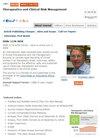预测腰椎退行性疾病患者椎弓根螺钉松动的手术前后 CT 图像纵向研究
IF 2.8
3区 医学
Q1 Pharmacology, Toxicology and Pharmaceutics
引用次数: 0
摘要
目的:我们进行了一项纵向研究,通过术前和术后的计算机断层扫描(CT)评估椎弓根螺钉松动的风险因素,研究其对椎弓根螺钉松动发生的预测作用:本研究共纳入103名接受过L4/5椎弓根螺钉固定术(涉及412枚螺钉)的退行性腰椎病患者。随后将他们分为两组--"松动组 "和 "非松动组"。测量术前和术后 CT 图像中螺钉轨迹的轴向和矢状角,并计算偏差角。此外,还测量了术前 CT 图像中螺钉进入点区域、椎弓根和椎体内的 Hounsfield 单位(HU)。采用逻辑回归分析确定影响螺钉松动发生的风险因素:结果:出现螺钉松动的老年患者往往在 L5 水平出现双侧螺钉问题(p < 0.005)。椎弓根的 HU 值(p < 0.001)、年龄(p < 0.001)和轴向偏差角(p = 0.014)被认为是预测螺钉松动的独立因素。此外,当椎弓根 HU < 126.5 或年龄≥ 53.5 岁时,发现螺钉松动组的轴偏角较小(p = 0.018 和 p = 0.019):结论:L5位置的螺钉松动在老年患者中更为常见,尤其是双侧患者。这种现象的独立预测因素包括:椎弓根的 HU 值较低,患者年龄较大,以及轴偏角较大。对于椎弓根 HU 值较低的老年患者,有必要减小轴向手术偏斜,以防止螺钉松动的发生。 关键词:计算机断层扫描;腰椎退行性疾病;Hounsfield 单位;椎弓根螺钉松动;位置偏差值本文章由计算机程序翻译,如有差异,请以英文原文为准。
Longitudinal Study on Pre- and Post-Operation CT Imaging for Predicting Pedicle Screw Loosening in Patients with Lumbar Degenerative Disease
Purpose: We conducted a longitudinal study to examine the predictive role of risk factors in the occurrence of pedicle screw loosening, assessed through pre- and post-operative computed tomography (CT) scans.
Methods: A total of 103 patients with degenerative lumbar disease who had undergone L4/5 pedicle screw fixation (involving 412 screws) were included in this study. They were subsequently categorized into two groups—the “loosening group” and the “non-loosening group”. The axial and sagittal angles of the screw trajectory in pre- and post-operative CT images were measured, and the deviation angles were computed. Additionally, measurements were taken of the Hounsfield unit (HU) within the screw entry point area, the pedicle, and the vertebral body in preoperative CT images. Logistic regression analysis was employed to ascertain the risk factors influencing the occurrence of screw loosening.
Results: Elderly patients who experienced screw loosening tended to have bilateral screw issues at the L5 level (p < 0.005). The HU of the pedicle (p < 0.001), age (p < 0.001), and the axial deviation angle (p = 0.014) were identified as independent factors predicting screw loosening. Additionally, when HU of the pedicle < 126.5 or age ≥ 53.5 years, the axial deviation angle was found to be smaller in the group experiencing screw loosening (p = 0.018 and p = 0.019).
Conclusion: Loosening of screws positioned at L5 was found to be more prevalent in elderly patients, particularly exhibiting a bilateral occurrence. Independent predictors of this phenomenon included a low HU value in the pedicle, advanced age in patients, and a substantial axial deviation angle. In the case of elderly patients with a low HU value in the pedicle, a reduced axial surgical deflection was necessitated to prevent the occurrence of screw loosening.
Keywords: computed tomography, lumbar degenerative diseases, Hounsfield unit, pedicle screw loosening, position deviation value
Methods: A total of 103 patients with degenerative lumbar disease who had undergone L4/5 pedicle screw fixation (involving 412 screws) were included in this study. They were subsequently categorized into two groups—the “loosening group” and the “non-loosening group”. The axial and sagittal angles of the screw trajectory in pre- and post-operative CT images were measured, and the deviation angles were computed. Additionally, measurements were taken of the Hounsfield unit (HU) within the screw entry point area, the pedicle, and the vertebral body in preoperative CT images. Logistic regression analysis was employed to ascertain the risk factors influencing the occurrence of screw loosening.
Results: Elderly patients who experienced screw loosening tended to have bilateral screw issues at the L5 level (p < 0.005). The HU of the pedicle (p < 0.001), age (p < 0.001), and the axial deviation angle (p = 0.014) were identified as independent factors predicting screw loosening. Additionally, when HU of the pedicle < 126.5 or age ≥ 53.5 years, the axial deviation angle was found to be smaller in the group experiencing screw loosening (p = 0.018 and p = 0.019).
Conclusion: Loosening of screws positioned at L5 was found to be more prevalent in elderly patients, particularly exhibiting a bilateral occurrence. Independent predictors of this phenomenon included a low HU value in the pedicle, advanced age in patients, and a substantial axial deviation angle. In the case of elderly patients with a low HU value in the pedicle, a reduced axial surgical deflection was necessitated to prevent the occurrence of screw loosening.
Keywords: computed tomography, lumbar degenerative diseases, Hounsfield unit, pedicle screw loosening, position deviation value
求助全文
通过发布文献求助,成功后即可免费获取论文全文。
去求助
来源期刊

Therapeutics and Clinical Risk Management
HEALTH CARE SCIENCES & SERVICES-
CiteScore
5.30
自引率
3.60%
发文量
139
审稿时长
16 weeks
期刊介绍:
Therapeutics and Clinical Risk Management is an international, peer-reviewed journal of clinical therapeutics and risk management, focusing on concise rapid reporting of clinical studies in all therapeutic areas, outcomes, safety, and programs for the effective, safe, and sustained use of medicines, therapeutic and surgical interventions in all clinical areas.
The journal welcomes submissions covering original research, clinical and epidemiological studies, reviews, guidelines, expert opinion and commentary. The journal will consider case reports but only if they make a valuable and original contribution to the literature.
As of 18th March 2019, Therapeutics and Clinical Risk Management will no longer consider meta-analyses for publication.
The journal does not accept study protocols, animal-based or cell line-based studies.
 求助内容:
求助内容: 应助结果提醒方式:
应助结果提醒方式:


